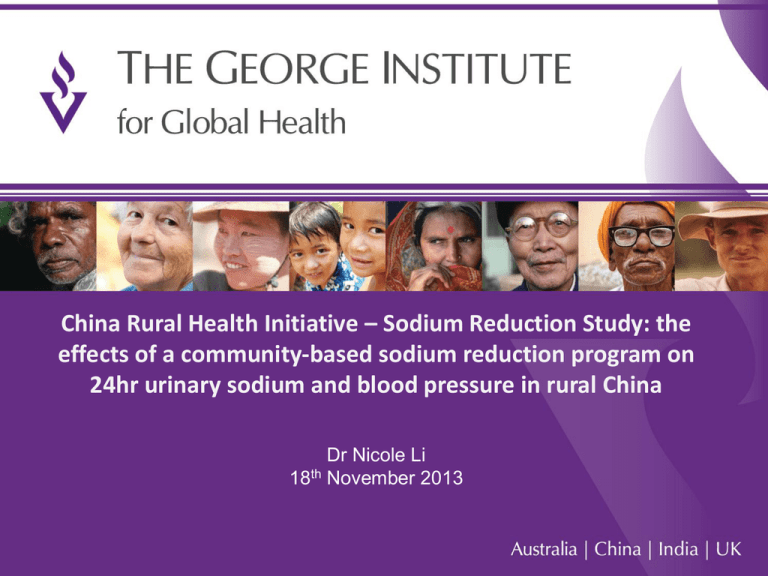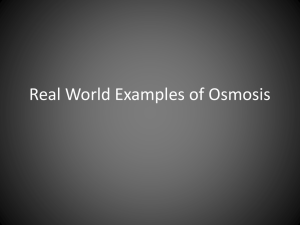
China Rural Health Initiative – Sodium Reduction Study: the
effects of a community-based sodium reduction program on
24hr urinary sodium and blood pressure in rural China
Dr Nicole Li
18th November 2013
1
Background
Cardiovascular diseases are the leading cause of
death in China, responsible for more than 3 million
deaths each year.
Stroke, high blood pressure and excess salt
consumption (12-15g/day) highly prevalent in rural
China
Little debate about the adverse effects of salt
consumption at this level, or the potential benefits of
salt restriction
2
Objective
To define the effects of a novel, low-cost,
scalable and sustainable, community-based
salt reduction strategy on salt consumption, as
estimated from 24-hour urinary sodium
excretion
3
3
Design
120 villages
60 villages in
intervention group
Randomized
60 villages in
control group
Randomized
30 villages without
price subsidy
30 villages with
price subsidy
4
Intervention and control
Intervention
Health education
Health belief model
Awareness
Beliefs
Behavior
Key messages
Implementation
Strategy
Access to salt substitute
Salt Substitute
+
65-75% NaCl
15-25% KCl
0-10%MgSO4
Double cost of usual
salt
Promotion of sales
Control: usual practice
5
5
Outcomes
Primary
24h urinary sodium (90% power,11mmol/day
difference)
Secondary
24-hour urinary potassium
Na/K ratio
Knowledge, attitude and practices
Systolic and diastolic blood pressure
Proportion with hypertension
Questionnaire, examination and 24hr urine
collection
6
Analysis
Intention to treat, no imputation for missing value
GEE model accounting for cluster effects
Primary comparison of 60 intervention vs. 60 control
villages
Secondary comparison of 30 price subsidy vs. 30 no price
subsidy villages
Pre-defined subgroups – age, sex, education, BMI,
smoking,alcohol
7
Survey data
60 intervention villages
1,295 questionnaire and examination
1,063 urine sample (82%)
59 control villages
1,272 questionnaire and examination
1,001 urine sample (77%)
8
Characteristics of survey
participants
Intervention Control
Female (%)
50
50
Age (years)
55
55
BMI (kg/m2)
24
24
Current smoker (%)
33
30
Drinks alcohol (%)
25
25
Education >9years (%)
32
31
Hypertension (%)
56
58
9
Effects on 24hr urinary
sodium and potassium
Intervention
300
250
200
150
100
50
0
Control
-13mmol (-26 to -1, p=0.03)
230
243
7mmol (4 to 10, p<0.001)
51
44
Sodium
Potassium
Na/K ratio -0.9(-1.2 to -0.5, p<0.001)
10
Effects on blood pressure outcomes
Systolic blood pressure
-1.0mmHg (-3·2 to 1·2), p=0.39
Diastolic blood pressure
-0·8mmHg (-2·3 to 0·8), p=0.34
Percent with hypertension
-2·2% (-5·5 to 1·2), p=0.20
11
Effects on knowledge and behaviors
60 Intervention
0
20
40
60
59 Control
80
100 0
Know salt is harmful
Know salt is harmful
Know daily limit is <6g/day
Know daily limit is <6g/day
Know reducing salt lowers BP
Know reducing salt lowers BP
Concerned about salt in diet
Concerned about salt in diet
Household uses salt substitute
Household uses salt substitute
30 Subsidy
20
40
30 No Subsidy
60
80
100
12
Interpretation
1.0g lower salt intake delivers:
1.8%-2.8% reduced risk of stroke
13mmol sodium reduction (0.75g Salt reduction):
1.4%-2.1% reduced risk of stroke
1.4%-2.1% reduction of 2 million new stroke cases ≈
28,000-42,000 strokes prevented each year in China
Additional effects of potassium supplementation not
included.
K. Bibbins-Domingo et al.. N Engl J Med. 20 Jan, 2010
13
Discussion
Strengths
Robust large scale randomized design
Excellent statistical power for primary outcome
Gold standard 24 hour urine collections
Simple, low-cost, scalable intervention
Weakness
Limited power for secondary blood pressure and hypertension
outcomes
14
Conclusions
Anticipated effects on sodium excretion were achieved
Effects appear to have been driven primarily by use of the
salt substitute (through provision of education and access)
Subsidization of the price of salt substitute was important
for uptake
Salt substitution has significant potential to reduce the large
burden of blood-pressure related disease in rural China
15
Acknowledgement
Sponsors
The US NIH NHLBI
The US CDC DHDSP
United Health Group
Partners
US CDC
The Duke University
The George Institute for Global Health, Australia
Peking University Health Science Center
China Medical University
Jiaotong University Medical College
Hebei Provincial CDC
Ningxia Medical University
Changzhi Medical University
16









